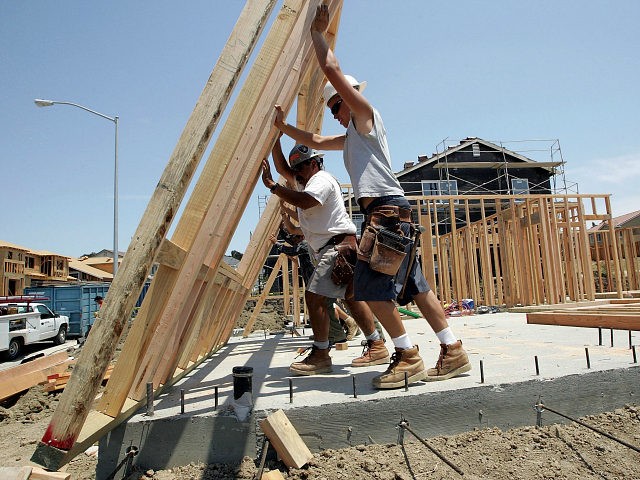The U.S. construction industry can build more houses by importing a huge number of foreign workers via the H-2A farm worker program, says an economist who is working for an investor group.
“How do we build more [housing] ASAP?” asked Adam Ozimek, an economist who works for an investor-backed advocacy group.
The answer, he said, is a “Dramatic one-time expansion of H2A visas for construction workers.”
The federal government already allows farm companies to import their own seasonal labor via the H-2A visa program, which is somewhat similar to the H-1B program used by the Fortune 500. In 2021, farm companies imported roughly 300,000 H-2A workers — effectively replacing many Americans who would have worked those jobs in exchange for decent wages.
Ozimek works for the Economic Innovation Group. The investor-backed group wants to gain by importing migrants into depopulated, once-wealthy areas, such as upstate New York. For example, the inflow of new migrants would help investors by boosting land prices, but would also hurt younger Americans by making housing more expensive.
Ozimek’s cheap-labor fix for a worker shortage is “like saying you’re gonna hit yourself on the head with a hammer until it stops hurting,” responded Steve Camarota, the research director at the Center for Immigration Studies.
“If you’re bringing in foreign labor and keeping wages down, then you’re constantly going to have a labor shortage,” he added.
But migration is a double benefit for construction companies, he said, adding: “If you can [use migration to] increase demand for housing and at the same time, lower the price of construction labor, that’s a win-win.”
Ozimek did not explain how the H-2A farm workers could legally be imported to build houses. He declined to answer questions from Breitbart News.
Slow moving pressure on the economy. How do we build more ASAP?
1. Remove lumber tariffs immediately and any other tariffs affecting construction prices
2. Dramatic one time expansion of H2A visas for construction workers https://t.co/SzwQzNlz9z
— Adam Ozimek (@ModeledBehavior) August 13, 2022
The federal policy of importing workers for favored business sectors “is one way the government puts its finger on the scale for business owners, and it’s not at all clear that that’s the best option for society,” he added.
For example, a shortage of American construction workers may spur companies to hire and train sidelined Americans, and also to develop new and more productive ways of building houses. The resulting productivity gains would raise average wages and allow ordinary Americans to buy more houses, Camarota said.
But any government supply of cheap outside labor encourages other companies to avoid making expensive investments in productivity, he said. In turn, that avoidance can deter other companies from taking the risk of developing the techniques, he said.
The same dilemma exists in the farm sector where many farm companies are reluctant to invest in robot technology until they see other companies succeed in using the robots. But few farm companies want to be the first to take that robot risk — especially if their business rivals are still using government-supplied cheap, low-risk, and disposable H-2A workers. Meanwhile, the farm companies’ widespread use of low-status, low-wage illegal workers and visa workers deter Americans from seeking jobs in the sector.
Currently, President Joe Biden’s border agencies are allowing roughly 200,000 economic migrants a month into the U.S. housing and labor markets. Simultaneously, per-person productivity in U.S. workplaces has dropped at a record pace.
But the government’s supply of labor also has had a huge civic impact.
Since the 1980s, a huge number of middle-class American construction workers have lost wages and careers after being sidelined by a massive wave of low-wage, low-tech migrants. In 2018, Blaine Taylor, a construction worker in California described the dramatic wage cuts caused by illegal migration into California:
If I hired a framer to do a small addition [in 1988], his wage would have been $45 an hour. That was the minimum for a framing contractor, a good carpenter … Now, the average wage in Los Angeles for construction workers is less than $11 an hour. They can’t go lower than the minimum wage. And much of that, if they’re not being paid by the hour at less than $11 an hour, they’re being paid per piece.
The wages not paid to the construction workers were split between profit-maximizing employers and cost-conscious consumers. The wholesale replacement of Americans also discouraged younger generations of blue-collar Americans from learning the skills needed for construction.
By allowing a steady inflow of foreign workers, “we’re making jobs that could be solidly middle class into lower-middle-class jobs,” Camarota said, adding:
Most working-class people worry about their child who doesn’t have a college degree ever being able to earn enough money to have a house. By most studies, over the last 30 or 40 years, people have seen either a stagnation or a decline in wages. There are exceptions at the very top, but overall — certainly for the non-college educated — we know for a fact they’re not doing well, and that’s a concern and now you’ve got the government putting his finger on the scale.
“Capital is getting a bigger share of the economic pie….. That’s one reason why the stock market has risen for the last 30 years, but not wages,” he said.

COMMENTS
Please let us know if you're having issues with commenting.